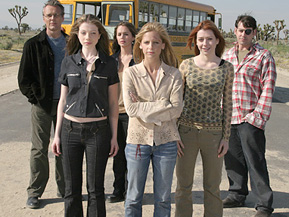Mythology: Buffy the Vampire Slayer's Impact
By Martin Felipe
October 30, 2009
BoxOfficeProphets.com

It didn't start out that way. The first season and a half of Buffy seemed that it was following a similar pattern to The X-Files. It would alternate between weekly vampire and demon slayings, and an ongoing arc in which we learn more about the demon world while Buffy and her gang battle the main villain, known on the show as the Big Bad. Not that this wasn't a good show; it just wasn't anything really special. Then, and I'm about to drop a massive spoiler here, her vampire lover Angel turns bad, and there is no turning back.
You see, the mythology show as a genre unto itself has seen many revolutions on the road to its current incarnation. Star Trek started it all. The adventures of the Enterprise are self-contained, but the world of the show is vast, complex and fascinating. Twin Peaks came along and merged the idea of serialization with a fantasy-based universe. X Files developed the long running arc alternating with Trek-like stand-alones. When Angel lost his soul on Buffy, a new model emerged, and, despite never having huge numbers, we still see the influence in today's shows.
Show-runner Joss Whedon developed a structure wherein each season is a self-contained story, and each story ties into each other story creating a seven intertwined story run. As I said before, each season features a Big Bad, many of whom contribute to the show's over-arching mythos. Beyond the structural blueprint, unlike most show-runners of the time, and many still, Whedon had no problems upsetting the status quo. Characters evolve, relationships change, and consequences of a character's action in one season remain relevant for many seasons to come.
Of course, this complex web of storytelling holds viewers to a higher standard. I don't mean to sound snooty. What I mean is that most television at the time was episodic as opposed to serialized. There were exceptions from the past like Dallas or Melrose Place, but these shows are ongoing, without an endpoint in mind. The value of an episodic structure is that viewers can jump in and out from week to week and not feel as if they'd missed something. The Dallas/Melrose structure is a little more complicated, but they're of the more-things-change-the-more-they-stay-the-same school. You may need a refresher on the details, but the big picture doesn't really vary. Even The X-Files had far more monster-of-the-week material than mythology episodes.
Buffy is more like a novel for television. All of the episodes contribute to a big picture, a picture the viewer may not see at first, but will become clear as the story reveals itself. Now this is a lofty goal for television, a commerce-based art form, which, at least at the time, relied on viewers for profitability. Problem is, the complexity of the narrative, the ever-evolving status quo had the potential to alienate casual viewers. As much as the show had a passionate following of fans who would never dare miss an episode, it also left many confused or afraid that they'd never be able to catch up. In today's landscape, with DVD, TiVo and Hulu, it's far easier for viewers to catch up, but Buffy's heyday was just prior to that revolution. The fact that so many novelistic shows have since sprung up on the cable networks and even on the networks is due more to this technology than to Buffy's success. While from week to week, such shows may not see the numbers that a House or a NCIS might, there's a new pastime of people watching season DVD sets and enjoying the long tale that they might have not had the time or commitment for in weekly installments. One of the first shows to benefit from this new viewing habit is 24, a show which nearly got cancelled after its first season. FOX released the season on DVD prior to the second season premier and now has a show than not only became one of their more prominent hits, but also has gotten to the overstaying-its-welcome phase of its run.
Of course, not all serialized mythology shows enjoy 24's ratings success, but they are profitable in their own way because of DVD sales or demographic desirability. The audience for these programs may be small, in first run anyway, but they're loyal, a predictable well of potential consumers for advertisers to target. Contrast this with the mega-crowds that consume weekly doses of CSI, but without passion or investment. Sponsors can see value in both types of viewers, which keep many of Buffy's progeny alive as a valuable commodity.
Which, in turn, makes me happy. Because, Heroes notwithstanding, I love these shows. I do think it's the highest form of television art. I'm resigned that they'll never be the ratings giants that CBS's procedurals are. I'll take their DVD success as a consolation prize. There are tons of profits to be made with these things, as evidenced by their saturation in the scripted-television market. As TV continues to splinter, the door will continue to open to the possibilities of television as a medium for quality storytelling. Now, if only Whedon's latest Dollhouse were profitable enough for FOX to grant him another miraculous season. That's highly unlikely at this point. They'll probably replace it with another vampire show.